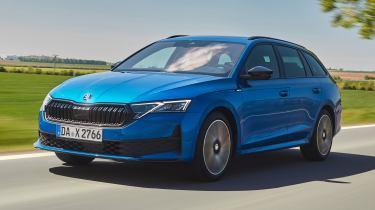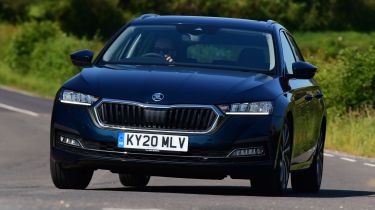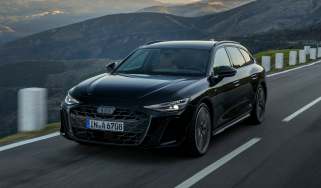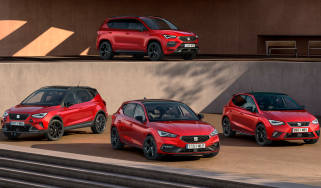Skoda Octavia Estate review – the class leader for practicality


If you have lots of things to transport, but don't want a large SUV with expensive running costs, a small estate could be the answer. They are stylish, affordable and cheap to run.
Since models such as the original Vauxhall Astra Estate were introduced in the 1980s, manufacturers have offered practicality-boosting estate versions of their hatchbacks, creating some of the world’s best small estates in the process. After all, once many millions have been spent designing and engineering a new model, it’s relatively simple to stretch the proportions of the boot in order to appeal to customers who need extra space.
With just as much room inside for passengers and very little sacrifice in performance or economy, you can have an estate that looks like your favourite hatchback but with enough boot space to carry bulky sports equipment, furniture or enough luggage for a fortnight of camping.
The popularity of SUVs and crossovers has shot up in recent years thanks to their practicality and toughness, but small estates still have a few advantages. The first is that the boot opening is closer to the ground, which can make loading heavy or awkward items like mountain bikes much easier. The lower height also pays dividends for fuel bills, because an estate’s sleeker shape will usually give it better fuel economy than an SUV with the same engine.
Driving enthusiasts will be happy too, because small estates normally handle just as well as their hatchback counterparts. Some of the models on our list are available as high-performance models too.
Here's our ranking of the top 10 best small estates cars available now.
The Skoda Octavia scores strongly in every area. Of the three cars based on the same VW Group underpinnings (including the Golf Estate itself and the SEAT Leon), the Octavia offers the most space, putting it in the lead from the off. The fourth-generation model boasts an impressive 640-litre boot, which is 30 litres larger than its predecessor. At 4.69m in length, it’s almost as big as cars in the next class up, such as the Audi A4 Avant. It’s also got a relatively high roofline, meaning three tall adults can comfortably sit in the back and enjoy plenty of head and leg room.
Despite its height, the Octavia Estate handles well in corners. Customers can choose from a range of petrol and diesel engines, which means there’s an Octavia Estate to suit most requirements. The more powerful 1.5-litre petrol engine can return up to 49.6mpg, while the smaller 1.0-litre can achieve around 54.3mpg. The 2.0-litre diesel, meanwhile, is capable of 63mpg. With both the petrol and diesel units emitting between 118g and 154g/km of CO2, they’re both affordable options for company-car drivers. There’s a vRS performance model, which is available as a plug-in hybrid and can return a claimed 233mpg. The petrol vRS version, however, boasts a 242bhp power output and can sprint from 0-62mph in 6.7 seconds.
Now in its third outing, the Ceed Sportswagon has gained more space and style. It's better to drive, too, if a little firmer-riding than before, with suspension that's more tightly wound and sharper steering. Stretched bodywork means its boot has grown to a competitive 625 litres, and top versions get a 40:20:40 split-folding rear bench for added flexibility.
In fact, equipment levels are one of the Ceed Sportswagon's main selling points, with even the 2 trim fitted with cruise control and a seven-inch touchscreen. A long seven-year warranty is another key consideration.
While the Skoda Octavia is the most practical of the Volkswagen Group trio and the Leon is the most stylish, the Golf is the most upmarket small estate in the class. Buyers could easily be won over by the Golf Estate’s interior compared to the alternatives, thanks to its excellent build quality and materials. It does, however, have the smallest boot of the three at 611 litres.
The Golf Estate can be had with 1.0-litre and 1.5-litre petrol engines, each with two different power outputs, which feature mild-hybrid technology on automatic versions and can return around 50mpg. The 2.0-litre diesel can manage 62mpg, making it a suitable option for owners who spend a lot of time commuting on motorways. For those who favour performance over practicality, there’s the 316bhp R model, which can sprint from 0-62mph in 4.9 seconds.
The Hyundai i30 Tourer boasts a 602-litre boot size and a range of economical petrol and diesel engines. It also offers a comfortable ride and impressive refinement, without being as fun to drive as the Leon ST or Ford Focus Estate.
Instead, the i30 Tourer impresses with its standard kit, value and dependable feel. With a five-year/unlimited-mileage warranty, any issues that do occur should be taken care of, and the i30 hatchback on which the Tourer is based also has a five-star Euro NCAP crash-test rating.
If you don’t necessarily need as much space as the Octavia Estate offers, the SEAT Leon can be thought of as a more stylish version of the same model. Having been given a refresh in 2020, the new Leon trades some luggage room for looks but can still carry a decent 620 litres behind the rear seats, which is an increase on the previous model.
The Leon Estate is also a desirable car for buyers who want the latest technology in their car, since it has plenty as standard. The interior looks modern and attractive too, with jutting air vents and an excellent driving position. It features a larger infotainment screen, which stands alone above the dashboard, alongside a digital instrument cluster. Physical dials have also been replaced with touch-sensitive sliders for the climate controls.
Like the Octavia, the Leon benefits from a wide engine range, spanning from economical petrol and diesel models to a plug-in hybrid version. The Cupra Leon Estate, which rivals the Octavia Estate vRS and Golf R estate, is available with punchy petrol and hybrid options.
The Peugeot 308 SW is perhaps the most striking car on this list, thanks to its angular design that is also found in its hatchback sibling. On the inside, the 308 SW feels much more premium than its price tag would suggest, with concept car-esque toggle switches, a widescreen infotainment screen and Peugeot’s configurable i-Cockpit digital instrument cluster. The Peugeot’s back seats are tighter than rivals in this class, but the 608-litre boot should be more than enough for most families.
Peugeot offers the 308 SW with a choice of a 128bhp engine in either petrol or diesel guise. We recommend opting for the 1.2-litre three-cylinder PureTech petrol option. This comes as standard with an eight-speed automatic gearbox and can manage over 50mpg on the motorway. If you’re looking for even more efficiency, there are also two plug-in hybrid powertrains on offer. While the range-topping 222bhp Hybrid 225 can be deemed overkill in terms of power and price, the entry-level 178bhp Hybrid 180 still provides enough punch and can manage up to 37 miles of pure-electric range.
The Ford Focus has always been a UK best-seller since its launch in 1998 and this latest iteration of the Focus estate is great for all of the same reasons. Its sharp, engaging steering is a step above many of its rivals and the Focus’ uncluttered interior is spacious and edging closer in quality to the latest Volkswagen Golf estate. Arguably most important in an estate is the boot and the Focus offers a generous 608 litres with the rear seats in place. This increases to a cavernous 1,650 litres with the seats folded down, turning your Focus into a mini-Transit van.
The Focus has recently been facelifted for 2022 and boasts a sharper exterior design as well as a larger 13.2-inch touchscreen in Titanium trim cars and above. However, all models benefit from full-LED headlights, a heated windscreen, air conditioning, smartphone connectivity and wireless charging, plus front and rear parking sensors. We recommend opting for a car with the 1.0-litre Ecoboost engine; the 153bhp version can manage 0-62mph in 9.4 seconds, but both allow you to make the most of the Focus’ superb chassis.
Buyers looking for an electric estate car currently have two options: the £80,000 Porsche Taycan Cross Turismo and the sub-£30,000 MG 5. But you won’t be disappointed by the MG, as long as you can get past its slightly odd styling and numb steering. Even the standard model will do up to 214 miles on a full charge, but a new long-range model joined the range in July 2021 and pushes that to 250 miles. Rapid charging at up to 50kW is even fitted as standard, which is sometimes left off pricier electric cars.
The MG 5 is also fairly practical, offering a decent boot and generous rear-seat space. The interior, while not the last word in luxury, is well-equipped - especially for the low price - with smartphone mirroring, parking sensors and cruise control fitted as standard. A seven-year, 80,000-mile warranty further sweetens the deal.
Those who like the retro style of the standard MINI, but need a car with a bit more practicality, might want to take a look at the MINI Clubman estate. The car's 360-litre boot is significantly bigger than the 211 litres in the back of the MINI hatchback, and the 'barn doors' used to access the space is a quirky design touch.
It's not just the styling of the hatchback that's been carried over to the Clubman estate, its driving dynamics have been retained, too, making the Clubman an enjoyable, responsive car to drive on a twisty road. There’s the odd compromise for family life, one of which is a softer suspension setup to make the Clubman more comfortable on longer trips and for passengers more generally. The car benefits from an impressive range of engines and comes with plenty of standard equipment, too.
The Megane Sport Tourer has a stylish design inside and out, which should appeal to image-conscious families. It represents a sensible buy thanks to a five-star Euro NCAP crash-test rating and low running costs. It’s now only available with a 1.6-litre plug-in hybrid, and the higher price of this engine does limit its appeal slightly. Petrol and diesel engines were also available until recently; the diesel can manage up to 63mpg while emitting just 119g/km of CO2. The E-Tech plug-in hybrid, meanwhile, can manage up to 30 zero-emission miles and an average total of 217.3mpg with 30g/km of CO2.
The talking point inside the Sport Tourer is the Tesla-style portrait orientation of the large 9.3-inch touchscreen, which comes as standard on the R.S. Line trim level. Entry-level cars are well-equipped as standard, with cruise control, dual-zone climate control, alloy wheels, sat nav Bluetooth, DAB radio and rear parking sensors.
Check out our guide to the best family cars to buy in 2021




